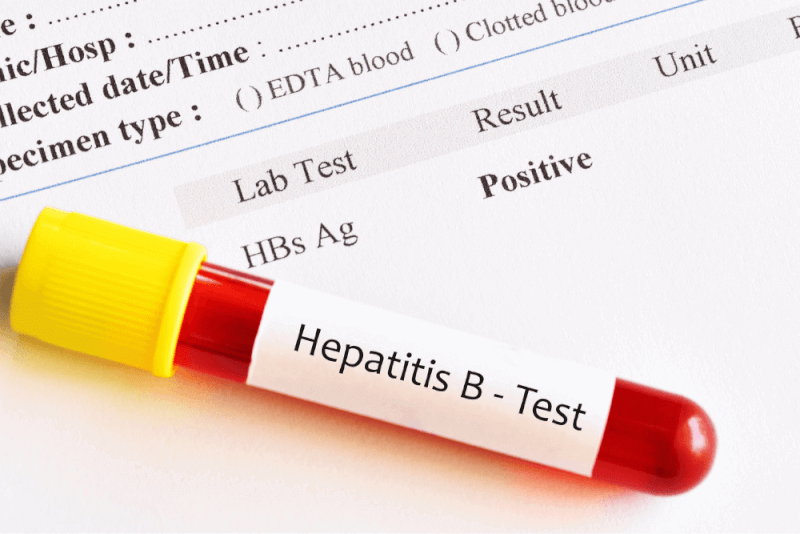30 Second Summary
- Hepatitis B, a serious liver infection caused by the HPV virus, is typically seen acutely.
- The chronicity of Hepatitis B increases the risk of liver failure, cirrhosis, and cancer.
- HPV virus-induced Hepatitis B spreads through body fluids and blood, but does not spread through the air via sneezing or coughing.
- The symptoms of Hepatitis B range from mild to severe. Typically, symptoms appear 1-4 months after infection.
What is Hepatitis B?
Hepatitis B is a serious liver infection caused by the HPV virus, typically seen acutely. This condition lasts for less than 6 months, but in some cases, the infection becomes chronic, lasting longer than 6 months. Chronic Hepatitis B increases the risk of liver failure, cirrhosis, and cancer.
Most adults with Hepatitis B recover completely, even if the symptoms are severe. However, infants and children are at a higher risk of developing long-term Hepatitis B. Although the Hepatitis B vaccine can prevent infection, there is no cure for Hepatitis B. Therefore, infected individuals need to take precautions to prevent the spread of the disease.
What is Recurrent Hepatitis B?
In some cases, after acute Hepatitis B has been recovered, an unidentified factor weakens the immune system. When this happens, a virus that was previously fought off by the immune system may reactivate, particularly the Hepatitis B virus. In these cases, the infection is more likely to become chronic, and the symptoms are more severe. In fact, many of these cases develop acute liver failure.
What Causes Hepatitis B?
Hepatitis B caused by the HPV virus spreads through body fluids and blood. However, it does not spread through the air by sneezing or coughing.
Symptoms of Hepatitis B
Symptoms of Hepatitis B vary from mild to severe. Typically, symptoms appear 1-4 months after infection, but in some cases, symptoms can appear within 2 weeks after infection. Some people, especially children, may not show any symptoms.
Common symptoms of Hepatitis B include:
- Abdominal pain
- Dark urine
- Fever
- Joint pain
- Nausea
- Vomiting
- Weakness and fatigue
- Jaundice (yellowing of the skin and eyes)
- Pale or clay-colored stool
- Swelling in the abdomen, arms, or legs
Diagnosis of Hepatitis B
The diagnosis of Hepatitis B is based on symptoms. Additionally, tests are done to diagnose complications that Hepatitis B may cause. These tests include:
Blood Tests
Blood tests can detect the presence of the Hepatitis B virus and determine whether the infection is acute or chronic. Blood tests can also assess whether the person has immunity against the disease.
Liver Ultrasound
A special type of ultrasound, called transient elastography, is used to assess whether there is any liver damage.
Liver Biopsy
A liver biopsy may be performed to assess liver damage. A small needle is inserted into the liver to collect tissue samples for laboratory examination.
How is Hepatitis B Transmitted?
Hepatitis B is transmitted through body fluids such as blood. The virus spreads when the body fluids of an infected person enter the body of a healthy person. The most common routes of transmission include:
Sexual Contact
Unprotected sexual intercourse with an infected person can transmit the virus. The virus can spread through infected blood, saliva, semen, or vaginal fluids.
Sharing Needles
HBV spreads easily through needles contaminated with infected blood. Sharing drug paraphernalia increases the risk of Hepatitis B transmission.
Accidental Needle Stick
Hepatitis B is a concern for healthcare workers and anyone who comes into contact with human blood.
Birth
Hepatitis B-infected pregnant women can pass the virus to their newborns during birth. However, newborns can be vaccinated shortly after birth to prevent infection in almost all cases.
The HPV virus can live outside the body for up to 7 days, so tools that are not sterilized could still contain the virus. These tools include medical instruments that cause bleeding, as well as commonly used items like toothbrushes or razors.
High-Risk Groups for Hepatitis B
The likelihood of contracting Hepatitis B increases in communities with higher infection rates. The more people infected in the community, the higher the chance of the virus spreading. High-risk groups include:
- 7.5% of people with HIV also have chronic Hepatitis B.
- Intravenous drug users have an increased risk of Hepatitis B infection.
- People from Africa, Asia, or the Pacific Islands are more likely to contract Hepatitis B.
Hepatitis B Vaccine
The only way to protect against Hepatitis B is through vaccination. It is safe for all children from birth to 18 years old. Additionally, adults who are at higher risk of contracting Hepatitis B, such as diabetics, are also recommended to get vaccinated.
Since all Hepatitis B vaccines have been synthetically produced since 1986, there is no risk of contracting the virus from the vaccine. Moreover, the vaccine helps prevent chronic Hepatitis B and is considered the leading vaccine to prevent liver cancer worldwide.
However, the vaccine does not benefit those who are already infected or immune. Therefore, it should be administered before exposure to the virus.
Hepatitis B Vaccine Doses
To ensure the effectiveness of the Hepatitis B vaccine, all doses should be administered at the recommended intervals. Infants born to infected mothers must be vaccinated within the first 12 hours of birth. The recommended vaccination schedule is as follows:
- The first dose can be administered at any time, but it is recommended to be given within the first 12 hours for newborns.
- The second dose should be given at least one month (28 days) after the first dose.
- The third dose should be given at least 4 months after the first dose or 2 months after the second dose. Infants should receive their third dose by 24 weeks old.
If any dose is missed, there is no need to restart the vaccination process. It is sufficient to complete the remaining doses. However, it is recommended to have an antibody test after completing the vaccination to confirm its success.
Where is the Hepatitis B Vaccine Given?
The Hepatitis B vaccine is an intramuscular injection, usually given in the gluteal area for maximum effectiveness.
Side Effects of the Hepatitis B Vaccine
With over 1 billion doses given worldwide, the Hepatitis B vaccine is considered one of the safest vaccines. Studies by international health organizations have shown no evidence that the vaccine causes autism, multiple sclerosis, or other neurological disorders.
Common side effects of the Hepatitis B vaccine include soreness, swelling, and redness at the injection site. The vaccine should not be given to individuals with a yeast allergy.
Difference Between Hepatitis B Infection and Carrier State
Individuals who recover from Hepatitis B infection develop immunity. However, 1 in 10 patients continues to carry the virus without developing symptoms. Carriers can still spread the virus, but typically show no symptoms. However, they can contribute to serious complications.
Treatment for Hepatitis B
Different treatment options are available depending on the severity of the Hepatitis B infection. These options include:
Prophylactic Treatment
Prophylactic treatment is given to prevent the virus from taking hold after exposure. This includes:
Vaccination
For unvaccinated individuals, the first dose of the Hepatitis B vaccine should be administered within 24 hours after exposure. To achieve full protection, a second dose should be administered within 6 months.
Hepatitis B Immunoglobulin (HBIG)
HBIG is a substance derived from human blood that contains natural antibodies against the Hepatitis B virus. It is administered to individuals who have been recently exposed to the virus to prevent infection.
These prophylactic treatments are especially effective in preventing the transmission of Hepatitis B to infants born to infected mothers. Infants who receive these treatments remain protected and can breastfeed safely.
Acute Hepatitis B Treatment
There is no specific treatment for Acute Hepatitis B, but patients should be monitored for complications, and supportive care may include:
- IV fluids
- IV nutrition
- Pain management
Chronic Hepatitis B Treatment
Patients with chronic Hepatitis B require lifelong treatment. The decision to start treatment depends on several factors, including:
- Whether the virus causes inflammation or scarring of the liver
- The presence of other infections, such as Hepatitis C or HIV
- Whether the immune system is compromised
The goal of treatment for Chronic Hepatitis B is to reduce the risk of liver damage and prevent the virus from spreading to others. Treatment options include:
Monitoring
Chronic Hepatitis B patients should be monitored every 6 months for liver health, including tests for liver function and signs of damage. These tests may include:
- Blood tests
- Imaging tests
- Liver stiffness measurement (elastography)
Medications
Some antiviral medications can help control active liver disease in Hepatitis B patients. These medications strengthen the immune system and slow down the virus's replication rate. While these medications do not completely eliminate the virus, they can help the liver stay healthy longer.
Immunomodulatory Drugs
Interferon-based drugs, such as peginterferon alfa-2a and interferon alfa-2b, help the body fight infections. These are typically given as injections over a period of 6-12 months and are often used as first-line treatment for adults.
Oral Medications
Oral antiviral medications are among the most effective options for controlling HBV. Depending on the patient's response, one or more antiviral drugs may be prescribed. These medications are typically required for lifelong use.
Liver Transplant
In cases of severe liver damage, a liver transplant may be necessary. The donor liver is typically obtained from deceased donors.
Lifestyle Changes
In addition to medication, lifestyle changes are necessary to prevent further liver damage. Patients are typically advised to reduce alcohol, sugar, and fat intake, as metabolic factors such as high BMI and triglycerides are leading contributors to liver inflammation.
Complications of Hepatitis B
Most complications from Hepatitis B are due to the chronicity of the infection. However, in some cases, complications may arise from acute infections. While rare, some individuals may develop liver failure with acute infections. This is a life-threatening situation.
Hepatitis D
Hepatitis D, also known as the delta virus, only affects people with Hepatitis B. Co-infection with both viruses is referred to as superinfection, which can increase liver stress and lead to acute liver failure.
Cirrhosis
People with chronic Hepatitis B may develop cirrhosis, a condition where liver tissue is replaced by scar tissue, leading to liver failure.
Chronic Liver Failure
Chronic liver failure occurs when the liver gradually loses its ability to function. It is often a consequence of cirrhosis and can be life-threatening. The only treatment is a liver transplant.
Liver Cancer
Chronic Hepatitis B significantly increases the risk of primary liver cancer. Hepatitis B is considered one of the leading causes of liver cancer, and liver cancer is the leading cause of death among people with chronic Hepatitis B.
Types of Hepatitis B
Hepatitis B can either be short-term or long-term. It is categorized into acute and chronic infections:
Acute Hepatitis B Infection
Acute Hepatitis B infections last for less than 6 months. The immune system typically clears the virus within a few months, and the patient fully recovers. Most cases of Hepatitis B are acute.
Chronic Hepatitis B Infection
Chronic Hepatitis B infections last for more than 6 months. Due to the immune system's inability to eliminate the virus, the infection persists and can last a lifetime. Some individuals with chronic Hepatitis B may not show symptoms, but fatigue and mild Hepatitis symptoms are common.
The younger a person is when they are infected, the higher the likelihood of the infection becoming chronic. Children under the age of 5 are especially at risk of developing chronic Hepatitis B, which can persist for years without being diagnosed.







